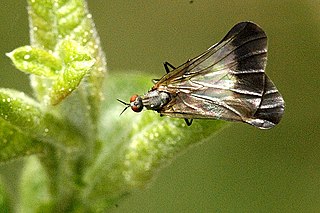| Phaeobalia | |
|---|---|
| Scientific classification | |
| Domain: | Eukaryota |
| Kingdom: | Animalia |
| Phylum: | Arthropoda |
| Class: | Insecta |
| Order: | Diptera |
| Family: | Empididae |
| Subfamily: | Clinocerinae |
| Genus: | Phaeobalia Mik, 1881 [1] |
| Type species | |
| Clinocera trinotata | |
| Phaeobalia | |
|---|---|
| Scientific classification | |
| Domain: | Eukaryota |
| Kingdom: | Animalia |
| Phylum: | Arthropoda |
| Class: | Insecta |
| Order: | Diptera |
| Family: | Empididae |
| Subfamily: | Clinocerinae |
| Genus: | Phaeobalia Mik, 1881 [1] |
| Type species | |
| Clinocera trinotata | |

Friedrich Hermann Loew was a German entomologist who specialised in the study of Diptera, an order of insects including flies, mosquitoes, gnats and midges. He described many world species and was the first specialist to work on the Diptera of the United States.

Tachydromia is a genus of hybotid flies. It is widespread around the world, with species found essentially everywhere except the polar regions and some remote islands. They are not very diverse in East and Southeast Asia, or in Africa

Rhagio is a worldwide genus of predatory snipe flies. Several species in this genus are referred to as downlooker or down-looker flies because they sometimes perch on tree trunks in a head-down position. There are approximately 170 species. They can be distinguished from other rhagionids by the open anal cell on the wings and the lack of a kidney-shaped arista.
Coracocephalus is a genus of flies in the family Dolichopodidae. It includes two species distributed in Austria.
Eucoryphus is a genus of flies in the family Dolichopodidae, with three species known from the Palearctic. It is found in the Alps and the mountains of southern Corsica.

Empis is a genus of dance fly found in the fly family Empididae.

Hilara is a genus of dance flies, in the fly family Empididae.

Rhamphomyia is a genus of dance flies, in the fly family Empididae. It contains more than 600 species in 8 subgenera.

Tachydromiinae is a subfamily of hybotid flies widespread in the world.
Brachymera is a genus of flies in the family Tachinidae.

Hydrophorinae is a subfamily of flies in the family Dolichopodidae. Several molecular phylogenetic analyses of the family have found evidence that the subfamily in its current sense is polyphyletic.
Bergenstammia is a genus of flies in the family Empididae. It is sometime treated as a sub-genus of Clinocera
Wiedemannia is a genus of flies in the family Empididae.
Chelifera is a genus of flies in the family Empididae.

Bicellaria is a genus of flies in the family Hybotidae.

Drapetis is a genus of flies in the family Hybotidae.

Oedalea is a genus of flies in the family Hybotidae.